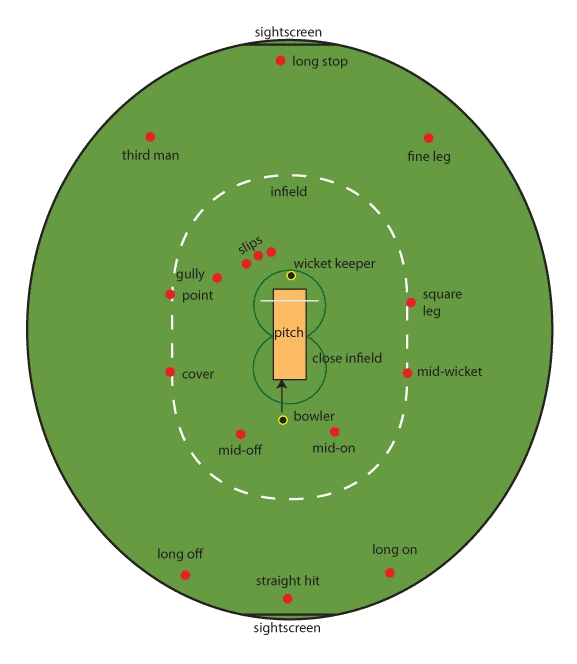
It is a game which requires precision in timing, skill, discipline and patience. Though cricket isn't always a spectacular showpiece, basic knowledge of the game will make it more enjoyable. Cricket is played with two teams of eleven, each with two umpires (referees) on an oval field. The size of the field varies, but generally has a diameter of around 200 metres.
A cricket bat is oblong shaped with a skinny handle. The bat in length is around 90 centimetres, or up to your waistline. A cricket ball is made of cork and coated with leather, and is then stitched up. For men's cricket, the ball weighs about 160gm and is about 226mm in circumference.
In the middle of the field is what is known as a pitch. A pitch is a hard, flat strip of dry ground around 18 metres long. Two batsman are at the pitch at a time, both at different ends, with one facing the delivery of the ball from the bowler. The bowler runs up to the pitch where he bowls the ball overarm but releases the ball before he reaches the crease, which is a white line painted on the pitch. If the bowler oversteps the line, there is a one run penalty.
Teams score by getting runs. A run is completed when a batsman hits the ball and then runs to the other end of the cricket pitch, getting past the crease. The non striking batsman has to run to the opposite end as well. The batsman can run as many times as they like, but the batsmen can get out if their stumps are hit with the ball by a fielder before the batsman reaches the crease. The stumps are three sticks of equal size measuring around 90 centimetres tall with 5 centimetres separating them. Bails (small pieces of wood) are balanced on top of the stumps. Other ways runs can be scored are by hitting boundaries. Boundaries are scored when the ball is hit and touches or goes past the outer edge of the field. Four runs are scored when the batsmen hits the ball and the ball hits the ground before reaching the outer edge of the boundary, and six runs are scored when the ball is hit and goes over the boundary without touching the ground. Runs can also be scored in the following ways: No balls, when the bowler oversteps the crease, bowls in a dangerous manner or incorrectly, or if the ball rises above the batsman's head. A no ball is worth one run. A wide is scored when the ball goes outside the line of the pitch before coming in line with the batsman. This is also worth one run. A leg bye is scored when the ball hits the batsman but doesn't contact his bat and then proceeds to run. A bye is scored when the batsman runs without the ball coming into into contact with the batsman or his bat, and then runs.
The fielding team can get the batsman out in several ways:
- Catching him out. This is done when the batsman hits the ball with his bat and a fielder catches the ball on the full.
- Bowling him out. This happens when the bowler bowls the ball and the ball strikes the batsmans stumps or bails.
- Leg before wicket, or LBW. This happens when the bowler bowls it and the stumps being hit by the ball are prevented when the batsman's leg gets in the way.
- Stumped, when the batsman comes forward to hit the hit but steps out of his crease, misses the ball and the fielder behind the stumps collects the ball hits the stumps before the batsman gets back behind his crease.
- Run out, when the batsman attempts to score a run but has his stumps hit by the ball before he reaches the other crease.
- Hit wicket, when the batsman hits his own stumps while trying to hit the ball.
- Retired, when the batsman voluntarily decides to finish his innings.
- Timed out, when the next batsman doesn't appear on the pitch within two minutes of the last batsman getting out.
Each team has one inning of 50 overs. An over is a series of 6 bowls by a bowler. Each bowler can only bowl 10 overs maximum, and can only bowl one over at a time. The team that scores the most runs in their innings is the team that wins.
If 10 of a team's batsman are out, the innings ends there regardless of how many balls are left to be bowled. A good score is 250 plus, and a disappointing score is around 150 or less, although it depends on the conditions of the area being played in. Sub tropical climates such as India or the Caribbean generally result in high scoring matches, exceeding 300 runs at times as the pitch is hard which results in more bounce. In a cooler climate however, such as England, the pitches generally are softer, which means the ball comes to the batsman at a slower pace which means there is less momentum when the ball is hit. This results generally in low scoring games.
There are different types of bowlers, fast, medium and spin. Fast bowlers bowl at full speed, sometimes at speeds of 160 kilometres per hour. Medium pace bowlers bowl at speeds of around 100 kilometres per hour but try to bowl in a style that will restrict the batsmen from scoring, notably by curving the ball as it flies through the air. A spin bowler bowls a lot slower, at around 75 kilometres per hour, but spins the ball so that it changes direction a lot after bouncing in order to deceive the batsman.
